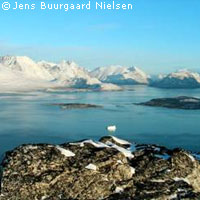Greenland once truly green, scientists reveal
Greenland was once truly green, according to new research which shows that the southern highlands of the country used to be home to a lush boreal forest. The work, which was partly funded by the EU's Marie Curie programme, is published in the latest edition of the journal Science. The scientists reached their conclusion after analysing ancient DNA from the base of an ice core taken at the Dye 3 site in southern Greenland. The samples revealed the presence at the site of trees such as alder, spruce, pine and yew as well as invertebrates such as beetles, flies, spiders, butterflies and moths. The samples were dated back to between 450,000 and 800,000 years ago, making them the oldest authenticated DNA obtained so far. 'Analysing ancient biomolecules from beneath glaciers and ice sheets is challenging due to the very low concentrations, but the information is worth the effort,' commented Dr Enrico Cappellini of the University of York, one of the authors of the paper. Knowing the environmental limits of the plants identified, the researchers believe that the average July temperatures at the time must have been over 10°C, while winter temperatures could not have been lower than -17°C. 'These findings allow us to make a more accurate environmental reconstruction of the time period from which these samples were taken, and what we've learned is that this part of the world was significantly warmer than most people thought,' commented Dr Martin Sharp of the University of Alberta. This ancient arctic forest disappeared and the land was covered in an ice sheet when temperatures fell during the subsequent ice age. However, when temperatures rose again some 116,000-130,000 years ago, the ice sheet remained in place, even though during that period, the temperature was 5°C warmer than today. 'If our data is correct, then this means that the southern Greenland ice cap is more stable than previously thought,' commented Professor Eske Willerslev of the University of Copenhagen, who lead the study. 'This may have implications for how the ice sheets respond to global warming.' However, Professor Willerslev is quick to note that this does not mean we should stop worrying about sea level rise resulting from global warming. 'We know that during the last interglacial, sea levels rose by five to six metres, but this must have come from other sources additional to the Greenland ice cap, such as Antarctic ice,' he notes. 'I would anticipate that as the Earth warms from man-made climate change, these sources would still contribute to a rise in sea levels.'



